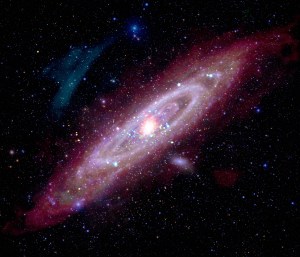
NASA’s Chandra Shares a New View of Our Galactic Neighbor
Astronomers study Andromeda (Messier 31, or M31) to understand the structure and evolution of our own spiral galaxy, the Milky Way. This new composite image contains data of M31 includes X-rays from Chandra and XMM-Newton, ultraviolet data from GALEX, optical data from astrophotographers using ground-based telescopes, infrared data from Spitzer, IRAS, COBE, Planck and Herschel, and radio data from the Westerbork Synthesis Radio Telescope. Each type of light reveals new information about this close galactic relative to the Milky Way.
Image Credit: X-ray: NASA/CXO/UMass/Z. Li & Q.D. Wang, ESA/XMM-Newton; Infrared: NASA/JPL-Caltech/WISE, Spitzer, NASA/JPL-Caltech/K. Gordon (U. Az), ESA/Herschel, ESA/Planck, NASA/IRAS, NASA/COBE; Radio: NSF/GBT/WSRT/IRAM/C. Clark (STScI); Ultraviolet: NASA/JPL-Caltech/GALEX; Optical: Andromeda, Unexpected © Marcel Drechsler, Xavier Strottner, Yann Sainty & J. Sahner, T. Kottary. Composite image processing: L. Frattare, K. Arcand, J.Major
- X
https://www.nasa.gov/image-detail/m31-3/
Image CreditX-ray: NASA/CXO/UMass/Z. Li & Q.D. Wang, ESA/XMM-Newton; Infrared: NASA/JPL-Caltech/WISE, Spitzer, NASA/JPL-Caltech/K. Gordon (U. Az), ESA/Herschel, ESA/Planck, NASA/IRAS, NASA/COBE; Radio: NSF/GBT/WSRT/IRAM/C. Clark (STScI); Ultraviolet: NASA/JPL-Caltech/GALEX; Optical: Andromeda, Unexpected © Marcel Drechsler, Xavier Strottner, Yann Sainty & J. Sahner, T. Kottary. Composite image processing: L. Frattare, K. Arcand, J.Major
Size7500x6442px



























